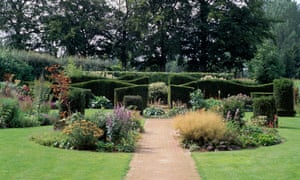Forget big names such as Kew and Versailles, these almost-secret gardens around the world are worth tracking down, for lovers of horticulture, sculpture – and the bizarre

Gatton Park, England
This year marks the 300th anniversary of the birth of English landscape gardener Lancelot “Capability” Brown, who created lakes, built hills and planted forests in the process of creating over 170 spectacular parks. Among his finest creations are Harewood in Leeds and Croome Park, Worcestershire (which has a wonderfulsecret walled garden), but those with a particular interest in Brown’s work should make the effort to visit some of his lesser-known creations. One of these is Gatton Park in Surrey, a 240-hectare (600 acre) park on which Brown worked in the 1760s. He created a series of ponds, a serpentine and a lake with two islands, offering picture-perfect views of the house through the trees and woodland. Also at Gatton Park is a Japanese garden and a rock garden, both built in the early 1900s.
• £4 entry, children free. Open to the public Feb-Oct on the first Sunday of each month, 1-5pm. Weekly tours take place Tues and Thurs at 2pm, £6. gattonpark.com
The Garden of Cosmic Speculation, Scotland
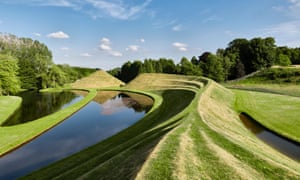
While the southern tip of England has its own surreal secret garden, in Cornwall’s mysterious Lost Gardens of Heligan , Scotland has an even stranger offering: the Garden of Cosmic Speculation. Built by landscape architect and postmodernistCharles Jencks, the cosmological garden features abstract land formations and terraces designed to evoke black holes, fractal geometry and other scientific and mathematical phenomena. It is only possible to visit the garden once a year, when it opens to the public to raise money for Maggie’s Cancer Caring Centres, a charity set up in memory of Jencks’s late wife.
• 2016 opening date, 1 May, noon-5pm, £7, £5 concessions, under-16s free,scotlandsgardens.org
Saihoji, Japan
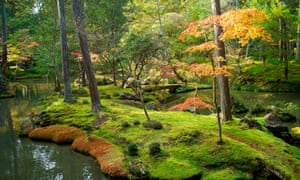
Another elusive secret garden is found at the Saihoji temple in Kyoto, Japan. The magical moss garden looks like the land of the fairies; soft yellow and green shades coat the floor like a deep-pile carpet surrounding the base of maple trees and bamboo groves. Considered the first Zen meditation garden, the ancient space was created in the Nara period, between 729-749. It was always inevitable that a place so beautiful would attract tourists, and since the 1970s, the Buddhist monks who tend it have put up a series of restrictions on visitors, which include getting a reservation by postcard and engaging in an activity, such as meditating or chanting sutras, before entering.
• £20 donation, apply at pref.kyoto.jp/isan/saihouji
Arctic-Alpine Botanic Garden, Norway
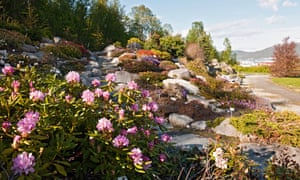
The world’s most northerly botanical garden is in Tromsø, Norway. Run by the Tromsø University Museum, which opened it in 1994, the garden pulls together specimens from the planet’s polar and mountain regions. The giant Tibetan blue poppy can be found in the Himalaya section, while rhododendron valley has over 60 species. The Arctic section is the one of the highlights of the garden, where you’ll find delicate flowers growing among the stones. These include a rare species of flower, the Wilander buttercup, which is only found in the icy archipelago of Svalbard. Rugged stuff indeed.
• Free, 1 June-31 August open daily 11am-4pm, 1 Sept-31 May open Sun 12pm-3.30pm, uit.no/botanisk
Chandigarh Rock Garden, India

The planned city of Chandigarh is not the most-visited destination in India (though if you’re looking for a break from the usual traffic chaos, a town built on a grid system is a good place to start), but it is home to one of the country’s more unusual attractions. Built secretly by government roads inspector Nek Chand, who started work on it in 1957 and died last year aged 90, the garden is a maze of sculptures and monuments built from scrap, rubble and household items he collected around the city. These have been transformed into concrete and ceramic sculptures of people, from queens and ministers to beggars and musicians as well as various animals. Although Chand never had permission to build on the site, and technically the garden and its sculptures were illegal, he managed to keep it under wraps for 18 years before the authorities became aware of it. Thanks to popular support, instead of being demolished, the garden remained open, with Chand employed to manage his park full time. The love and attention he gave it can still be appreciated today.
• Adults 20p, children 10p, 1 Apr-30 Sept 9am-7.30pm, 1 Oct-31 Mar 9am-6pm,nekchand.com
Piet Oudolf Private Garden, Netherlands
Piet Oudolf is considered one of the great contemporary landscape gardeners, known as the figurehead of the New Perennial movement – which experimented with grasses and herbaceous borders – and for his work on projects such as New York’s High Line and Chicago’s Lurie Garden. While the High Line is visited by around five million people each year, those who want to have a more intimate insight into Oudolf’s world should visit his and wife Anja’s private garden in the Dutch village of Hummelo. In the garden, you’ll be able to see the flourishes and cascades of colour that Oudolf is known for, that change dramatically throughout the year. Though it’s a pilgrimage site for followers of Oudolfs design, bear in mind that the garden is a private space and has limited opening hours – if you want to visit outside of these you must make an appointment.
• €3.50, open Thurs-Sat, 1 Jun-22 Oct, 11am-4pm, closed 3-28 July,oudolf.com/private-garden
Las Pozas, Mexico
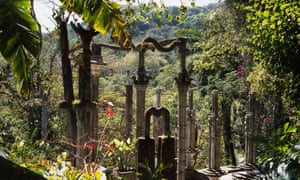
A secret subtropical sculpture park, Las Pozas occupies 80 acres of rainforest in the mountains near the Mexican village of Xilitla. The unusual park came into being in 1962 when English poet and surrealist Edward James (who attended Eton and Oxford and was basically an eccentric posho), began creating a sculpture garden on a coffee plantation he had bought with the proceeds of selling his collection of surrealist art. The garden features 36 of James’s otherworldly constructions, from staircases to nowhere to abstract concrete waterfalls and works with names such as “The House on Three Floors Which Will in Fact Have Five or Four or Six”. These sit among lush vegetation, blooming trees, orchids and other native tropical plants.
• £10 for a guided tour of the gardens, open all year round 9am-6pm. xilitla.org
Gardens of Ninfa, Italy
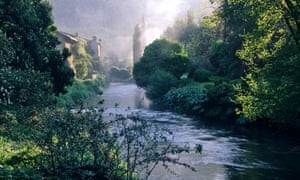
Romantic in the extreme, these beautiful gardens south-east of Rome in the Lazio region are like the backdrop for a Shakespeare play. In it, you’ll find medieval ruins, a temple dedicated to nymphs, a lake with an island and various springs, rivers and waterways – the natural habitat of the mythical female deities. Created in 1921 by Gelasio Caetani, the garden follows an English style, with naturalistic features, romantic hideaways and meandering walkways. It is by no means a well-known spot: visiting it, as with many of the more unusual gardens around the world, can be tricky, thanks to idiosyncratic opening hours, but with over 1,000 plant species, carefully landscaped to create a magical lovers’ paradise, it’s well worth the effort.
• €12 adults, children free, open Apr-Oct on specific dates, check website for details. fondazionecaetani.org/visita_ninfa
Tarot Garden, Tuscany, Italy

French sculptor and painter Niki de Saint Phalle, who died in 2002, and her sculptor husband Jean Tinguely spent 14 years creating this garden, representing the 22 major arcana of the Tarot. The “cards” are actually colourful and imposing reinfored concrete buildings, up to 15 metres high, covered in ceramic tiles, mirror mosaics and coloured glass. You enter via a circular gateway in a long perimeter wall created by Swiss architect Mario Botta to emphasise the contrast between everyday outside and fantastical garden inside is very striking. The garden is now run by a trust, which maintains all the installations, but in accordance with de Saint-Phalle’s wishes, entrance is free on the first Saturday of each month in the winter, though this is deliberatly not widely publicised – it couldn’t cope with huge crowds.
•€12, concessions €7, under-sevens free, open daily April-15 October, 2.30pm-7.30pm. ilgiardinodeitarocchi.it
Mainau Island, Germany
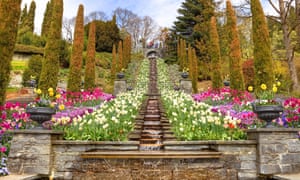
Known as the “flower island”, Mainau Island sits in Lake Constance in southern Germany, and is bursting with thousands of species of flowers. There’s also a 150-year-old arboretum with looming redwood trees, and a palm house with a collection of 1,200 orchids. Other popular features are the butterfly house – the largest in the country and filled with more than 1,000 colourful butterflies – and the rose garden, with 9,000 plants from 400 species. The island also has a 13th-century baroque palace, which adds an extra touch of magic to the already ostentatious isle.

